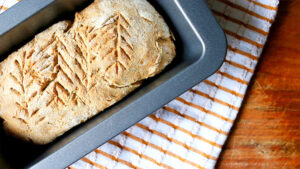Nutritional Value of Bread
The art of bread making dates back over 4000 years. Its form and recipe have changed through time and across different climates where it was prepared, so today bread varieties and their production methods differ significantly around the world. Industrially prepared doughs, bread and bakery products often contain various additives and higher amounts of salt to extend shelf life, improve taste and texture, and speed up production processes. This is why homemade bread consumption – bread without additives, prepared at home – is increasingly promoted.
All about Bread Ingredients
According to the Regulation on Cereals and Cereal Products, bread is a bakery product made by mixing, shaping, rising or fermentation, and baking dough mixed from several basic ingredients. The basic ingredients of every bread are flours from so-called bread cereals, then water, yeast and salt. However, other ingredients are very often added to the basic recipe to improve texture, taste, shelf life and the nutritional value of the bread itself.
Cereals, or cereal flours as the main ingredient of bread, largely determine its nutritional value, mineral composition and taste properties.
Wheat represents the dominant cereal in bread production, precisely because of the excellent properties of its flour, ideal for bread preparation. However, in recent times, many other cereals, such as rye, corn, millet and oats, or their flours, are becoming part of the basic bread ingredients. Additional enrichment of bread with excellent sources of dietary fiber, unsaturated fats and minerals such as sesame, sunflower, flax seeds and psyllium is becoming increasingly popular precisely to improve the nutritional value of the bread itself.

Cereals as a Source of Vitamins and Minerals
From a nutritional perspective, complex carbohydrates, or starch as the main source of energy in our diet, make up as much as 80% of the nutritional component in bread composition. With the addition of seeds, a significant portion of carbohydrates in bread is also made up of dietary fiber, whose health benefits are increasingly being researched and confirmed.
Although it largely depends on the type of basic cereal in the bread, the proportion of proteins and fats in bread is not negligible. Moreover, cereals together with seeds represent a source of plant proteins and essential amino acids, as well as some essential fatty acids and phytosterols, which significantly improves the nutritional profile of bread.
Regarding vitamins and minerals, it has been shown that cereals are an excellent source of B vitamins and minerals, among which phosphorus, calcium and magnesium, as well as potassium and sodium stand out.
Yeast also significantly contributes to the nutritional value of bread, as it is known to contain all nine essential amino acids and is considered a high-quality source of protein, B vitamins and trace minerals such as zinc, selenium, manganese and copper, which participate in regulating metabolism and immune system function.

